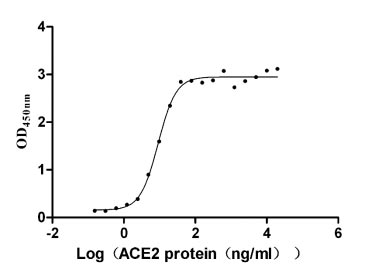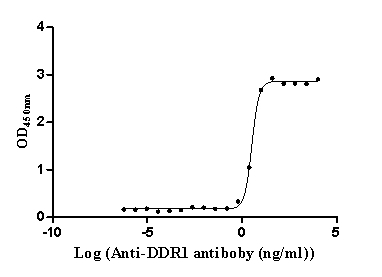Recombinant Mouse Tumor suppressor p53-binding protein 1 (Tp53bp1)
-
中文名称:小鼠Tp53bp1重组蛋白
-
货号:CSB-YP024080MO
-
规格:
-
来源:Yeast
-
其他:
-
中文名称:小鼠Tp53bp1重组蛋白
-
货号:CSB-EP024080MO
-
规格:
-
来源:E.coli
-
其他:
-
中文名称:小鼠Tp53bp1重组蛋白
-
货号:CSB-EP024080MO-B
-
规格:
-
来源:E.coli
-
共轭:Avi-tag Biotinylated
E. coli biotin ligase (BirA) is highly specific in covalently attaching biotin to the 15 amino acid AviTag peptide. This recombinant protein was biotinylated in vivo by AviTag-BirA technology, which method is BriA catalyzes amide linkage between the biotin and the specific lysine of the AviTag.
-
其他:
-
中文名称:小鼠Tp53bp1重组蛋白
-
货号:CSB-BP024080MO
-
规格:
-
来源:Baculovirus
-
其他:
-
中文名称:小鼠Tp53bp1重组蛋白
-
货号:CSB-MP024080MO
-
规格:
-
来源:Mammalian cell
-
其他:
产品详情
-
纯度:>85% (SDS-PAGE)
-
基因名:
-
Uniprot No.:
-
别名:Tp53bp1; Trp53bp1; TP53-binding protein 1; 53BP1; p53-binding protein 1; p53BP1
-
种属:Mus musculus (Mouse)
-
蛋白长度:Partial
-
蛋白标签:Tag type will be determined during the manufacturing process.
The tag type will be determined during production process. If you have specified tag type, please tell us and we will develop the specified tag preferentially. -
产品提供形式:Lyophilized powder
Note: We will preferentially ship the format that we have in stock, however, if you have any special requirement for the format, please remark your requirement when placing the order, we will prepare according to your demand. -
复溶:We recommend that this vial be briefly centrifuged prior to opening to bring the contents to the bottom. Please reconstitute protein in deionized sterile water to a concentration of 0.1-1.0 mg/mL.We recommend to add 5-50% of glycerol (final concentration) and aliquot for long-term storage at -20℃/-80℃. Our default final concentration of glycerol is 50%. Customers could use it as reference.
-
储存条件:Store at -20°C/-80°C upon receipt, aliquoting is necessary for mutiple use. Avoid repeated freeze-thaw cycles.
-
保质期:The shelf life is related to many factors, storage state, buffer ingredients, storage temperature and the stability of the protein itself.
Generally, the shelf life of liquid form is 6 months at -20°C/-80°C. The shelf life of lyophilized form is 12 months at -20°C/-80°C. -
货期:Delivery time may differ from different purchasing way or location, please kindly consult your local distributors for specific delivery time.Note: All of our proteins are default shipped with normal blue ice packs, if you request to ship with dry ice, please communicate with us in advance and extra fees will be charged.
-
注意事项:Repeated freezing and thawing is not recommended. Store working aliquots at 4°C for up to one week.
-
Datasheet :Please contact us to get it.
靶点详情
-
功能:Double-strand break (DSB) repair protein involved in response to DNA damage, telomere dynamics and class-switch recombination (CSR) during antibody genesis. Plays a key role in the repair of double-strand DNA breaks (DSBs) in response to DNA damage by promoting non-homologous end joining (NHEJ)-mediated repair of DSBs and specifically counteracting the function of the homologous recombination (HR) repair protein BRCA1. In response to DSBs, phosphorylation by ATM promotes interaction with RIF1 and dissociation from NUDT16L1/TIRR, leading to recru...显示更多
-
基因功能参考文献:
- mediates changes in chromatin architecture that affect break order. PMID: 27320916
- this study shows that 53BP1 is required for three-dimensional organization of the immunoglobulin heavy chain locus and provides a plausible explanation for the link with 53BP1 enforcement of deletional immunoglobulin class switch recombination PMID: 28159901
- Genomic instability can be rescued by the deletion of Trp53bp1, which encodes the DNA damage response factor 53BP1, and mice expressing RING-less BRCA1 do not show an increased susceptibility to tumors in the absence of 53BP1. PMID: 27670884
- Unlike directly induced DSBs, secondary DSBs were not efficiently repaired, although Rad51 and 53BP1 were recruited to these sites. H2AX was dramatically stabilized in response to DSBs directly caused by gamma-rays, enabling gammaH2AX foci formation and DSB repair, whereas H2AX was barely stabilized in response to secondary DSBs, in which gammaH2AX foci were small and DSBs were not efficiently repaired PMID: 27251002
- Study showed that mammalian cells use microtubules in the cytoplasm to promote the mobility of sites of DNA damage in the nucleus; molecular details of this process remain to be determined, the main players, including the MOB domain of 53BP1, the linker of the nucleoskeleton, and cytoskeleton complex, kinesins, and microtubules are now known, allowing further study. PMID: 26544937
- These experiments define a novel requirement for 53BP1 in the fusions of DNA-PKcs-deficient telomeres throughout the cell cycle. PMID: 25264618
- Study concludes that only the 53BP1 status in DNA lesions, induced by UVA or gamma-rays, is affected by A-type lamin deficiency, which was not observed for heterochromatin-related proteins HP1beta and BMI1. PMID: 24611931
- Binding of 53BP1 to methyl K810 occurs on E2 promoter binding factor target genes and allows pRb activity to be effectively integrated with the DNA damage response. PMID: 25049398
- study uncovers novel ATM-independent functions for 53BP1 in the suppression of oncogenic translocations and in radioprotection PMID: 23858098
- Study concludes that 53BP1 promotes productive class switch recombination and suppresses mutagenic DNA repair through distinct phosphodependent interactions with RIF1 and PTIP. PMID: 23727112
- Thus, RIF1 and 53BP1 cooperate to block DSB resection to promote NHEJ in G1, which is antagonized by BRCA1 in S phase to ensure a switch of DSB repair mode to homologous recombination PMID: 23333305
- loss of 53BP1 alters the translocatome by increasing rearrangements to intergenic regions. PMID: 23290917
- A mutant lacking the oligomerization domain (53BP1(oligo)) was only modestly impaired in promoting NHEJ of dysfunctional telomeres and showed no defect with regard to the repression of CtIP. PMID: 23345425
- data establish Rif1 as an important contributor to the control of double-strand break repair by 53BP1 PMID: 23306437
- deletion of 53BP1 in TRF1-deficient cells impairs the C-NHEJ repair pathway, decreasing the occurrence of chromosome-type end to end telomere fusions while inducing a persistent DNA damage signal that activates the ATR-dependent DDR and HR repair pathways PMID: 22508511
- XLF repair protein and 53BP1 DNA damage response factor have overlapping functions in end joining and lymphocyte development PMID: 22355127
- find that combined XLF/53BP1 deficiency in mice severely impairs C-NHEJ, V(D)J recombination, and lymphocyte development while also leading to general genomic instability and growth defects PMID: 22308489
- Data suggest a link between recruitment of 53BP1, resolution of DNA damage, and increased species lifespan. PMID: 21931182
- A novel pathway regulates the levels of 53BP1 & the repair of DNA DSBs by the NHEJ pathway. The central player is cathepsin L which is impacted upon by the loss of A-type lamins and can be regulated by treatment with vitamin D. PMID: 21750527
- Roles of Dot1L and 53Bp1 in gene expression and the control of DNA double-strand repair pathways in the context of chromatin. PMID: 21383990
- Data elucidate the molecular events that are required for 53BP1 to maintain genomic stability and point to a model wherein 53BP1 and H2AX cooperate to repress resection of DSBs PMID: 21549309
- Loss of both 53Bp1 and Brca1 rescues the inviability of Brca1-deficient mice, without increasing tumourigenesis. PMID: 20724228
- Data show that ATM-dependent resection at a subset of DSBs leads to ATR-dependent Chk1 activation, and that 53BP1(-/-) and MDC1(-/-) cells manifest a checkpoint defect at high radiation doses. PMID: 20421415
- Data show that H2AX is essential for viability in a PARP1-deficient background, while deficiency for 53BP1 modestly exacerbates phenotypes of growth retardation, genomic instability, and organismal radiosensitivity observed in PARP1-deficient mice. PMID: 20231360
- 53BP1 protein binds to Rnf8, suggesting DNA damage involves RNF8 dependent ubiquitylation, which allows its accumulation at damaged chromatin. PMID: 20385748
- Study shows that DNA breaks in Brca1-deficient cells are aberrantly joined into complex chromosome rearrangements by a process dependent on the nonhomologous end-joining (NHEJ) factors 53BP1 and DNA ligase 4. PMID: 20362325
- 53BP1 regulates the choice of end-joining pathways by interfering with resection, thereby favoring classical nonhomologous end joining (C-NHEJ) during class switch regulation.. PMID: 20368578
- m53BP1(tr/tr) mice are sensitive to ionizing radiation and cells from these animals exhibit chromosomal abnormalities consistent with defects in DNA repair, indicating that 53BP1 is a critical element in the DNA damage response. PMID: 12578828
- 53BP1 acts downstream of ATM and upstream of Chk2 in the DNA damage response pathway and is involved in tumor suppression PMID: 12640136
- Data show that the major globular domain of the 53BP1 central region adopts a new structural motif composed of two tightly packed Tudor domains and a C-terminal alpha helix. PMID: 15341721
- Snm1 and 53BP1 are components of a mitotic stress checkpoint that negatively targets the APC prior to chromosome condensation PMID: 15542852
- RNA has a role in the binding of 53BP1 to chromatin damaged by ionizing radiation PMID: 15840649
- 53BP1 at DSBs significantly lagged behind Mdc1/NBD1. PMID: 16009723
- p53 binding protein 1 (53BP1) plays a role in stabilizing the synapsis of switch regions during immunoglobulin class switch recombination. PMID: 17183606
- 53BP1 is dispensable for signalling apoptosis and cell-cycle arrest in the intestinal epithelium PMID: 17452983
- Results show that 53BP1 functions in XRCC4-dependent nonhomologous end-joining, likely mediated by its interaction with dimethylated lysine 20 of histone H4, independent of H2AX. PMID: 18158901
- MDC1 functions as an upstream regulator of 53BP1 in the DDR pathway and in tumor suppression PMID: 18504301
- data suggest a more general role for 53BP1 in maintaining genomic stability during long-range joining of DNA breaks PMID: 18931658
- 53BP1, which is known to be recruited to DNA damage sites, is undetectable at mitotic chromosomes and its localisation changes upon blastocyst formation from mainly nuclear to cytoplasmic. PMID: 19598117
- Report a selective requirement for 53BP1 in the biological response to genomic instability induced by Brca1 deficiency. PMID: 19716796
收起更多
-
亚细胞定位:Nucleus. Chromosome. Chromosome, centromere, kinetochore.
-
数据库链接:
KEGG: mmu:27223
STRING: 10090.ENSMUSP00000106278
UniGene: Mm.215389




-AC1.jpg)















